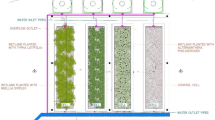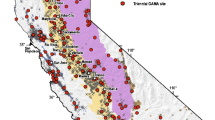Abstract
Surface water is at risk from Marcellus Shale operations because of chemical storage on drill pads during hydraulic fracturing operations, and the return of water high in total dissolved solids (up to 345 g/L) from shale gas production. This research evaluated how two commercial, off-the-shelf water quality sensors responded to simulated surface water pollution events associated with Marcellus Shale development. First, peak concentrations of contaminants from typical spill events in monitored watersheds were estimated using regression techniques. Laboratory measurements were then conducted to determine how standard in-stream instrumentation that monitor conductivity, pH, temperature, and dissolved oxygen responded to three potential spill materials: ethylene glycol (corrosion inhibitor), drilling mud, and produced water. Solutions ranging from 0 to 50 ppm of each spill material were assessed. Over this range, the specific conductivity increased on average by 19.9, 27.9, and 70 μS/cm for drilling mud, ethylene glycol, and produced water, respectively. On average, minor changes in pH (0.5–0.8) and dissolved oxygen (0.13–0.23 ppm) were observed. While continuous monitoring may be part of the strategy for detecting spills to surface water, these minor impacts to water quality highlight the difficulty in detecting spill events. When practical, sensors should be placed at the mouths of small watersheds where drilling activities or spill risks are present, as contaminant travel distance strongly affects concentrations in surface water systems.







Similar content being viewed by others
References
American Petroleum Institute (API). (2010). Water management associated with hydraulic fracturing. Report HF2. American Petroleum Institute. http://www.shalegas.energy.gov/resources/HF2_e1.pdf. Accessed 16 September 2016.
Bedient, P.B., & Huber, W.C. (2001). Hydrology and Floodplain Analysis. Camden, NJ: Pearson.
Betanzo, E.A., Hagen, E.R., Wilson, J.T., Reckhow, K.H., Hayes, L., Argue, D.M., & Cangelosi, A.A. (2016). Water data to answer urgent water policy questions: monitoring design, available data, and filling data gaps for determining whether shale gas development activities contaminate surface water or groundwater in the Susquehanna River Basin. Northeast-Midwest Institute. http://www.nemw.org/. Accessed 16 September 16.
Brantley, S., Yoxtheimer, D., Arjmand, S., Grieve, P., Vidic, R., Pollak, J., Llewellyn, G., Abad, J., & Simon, C. (2014). Water resource impacts during unconventional shale gas development: the Pennsylvania experience. International Journal of Coal Geology, 126, 140–156.
Caenn, R., Darley H., & Gray, G. (2011). Composition and properties of drilling and completion fluids. Oxford: Gulf Professional Publishing.
Caissie, D., Pollock, T., & Cunjak, R. (1996). Variation in stream water chemistry and hydrograph separation in a small drainage basin. Journal of Hydrology, 178, 137–157.
Clark, C. E., Burnham, A. J., Harto, C. B., & Horner, R. M. (2012). The technology and policy of hydraulic fracturing and potential environmental impacts of shale gas development. Environmental Practice, 14, 249–261.
Emerson, D.G., Vecchia, A.V., & Dahl, A.L. (2005). Evaluation of drainage-area ratio method used to estimate streamflow for the Red River of the North Basin, North Dakota and Minnesota. Scientific Investigations Report 2005–5017, Reston, VA: U.S. Geological Survey.
Entrekin, S., Evans-White, M., Johnson, B., & Hagenbuch, E. (2011). Rapid expansion of natural gas development poses a threat to surface waters. Frontiers in Ecology and the Environment, 9(9), 503–511.
FracFocus. (2016). What chemicals are used. FracFocus Chemical disclosure registry. https://fracfocus.org/chemical-use/what-chemicals-are-used. Accessed 16 September 16.
Gregory, K. B., Vidic, R. D., & Dzombak, D. A. (2011). Water management challenges associated with the production of shale gas by hydraulic fracturing. Elements, 7, 181–186.
Guasch, H., Armengol, J., Marti, E., & Sabater, S. (1998). Diurnal variation in dissolved oxygen and carbon dioxide in two low-order streams. Water Research, 32(4), 1067–1074.
Haluszczak, L. O., Rose, A. W., & Kump, L. R. (2013). Geochemical evaluation of flowback brine from Marcellus gas wells in Pennsylvania, USA. Applied Geochemistry, 28, 55–61.
Hammack, R., Harbert, W., Sharma, S., Stewart, B., Capo, R., Wall, A., Wells, A., Diehl, R., Blaushild, D., Sams, J., & Veloski, G. (2014). An evaluation of fracture growth and gas/fluid migration as horizontal Marcellus Shale gas wells are hydraulically fractured in Greene County, Pennsylvania; NETL-TRS-3-2014, EPAct Technical Report Series, Pittsburgh, PA: U.S. Department of Energy, National Energy Technology Laboratory.
Hayes, T. (2009). Sampling and analysis of water streams associated with the development of Marcellus Shale gas, final report for Marcellus Shale Coalition.
Jobson, H.E. (1996). Prediction of travel time and longitudinal dispersion in rivers and streams. Reston, VA: U.S. Geological Survey.
King, G.E. (2012). Hydraulic fracturing 101: what every representative, environmentalist, regulator, reporter, investor, university researcher, neighbor, and engineer should know about estimating frac risk and improving frac performance in unconventional gas and oil wells. In Society of Petroleum Engineers, Hydraulic Fracturing Technology Conference. (152596). SPE.
Lee, D. S., Herman, J. D., Elsworth, E., Kim, H. T., & Lee, H. S. (2011). A critical evaluation of unconventional gas recovery from the Marcellus Shale, Northeastern United States. KSCE Journal of Civil Engineering, 15(4), 679–687.
Lutz, B. D., Lewis, A. N., & Doyle, M. W. (2013). Generation, transport, and disposal of wastewater associated with Marcellus Shale gas development. Water Resources Research, 49, 647–656.
Maloney, K. O., & Yoxtheimer, D. A. (2012). Production and disposal of waste materials from gas and oil extraction from the Marcellus Shale play in Pennsylvania. Environmental Practice, 14(4), 279–287.
McDonald, J. H. (2014). Handbook of Biological Statistics. Baltimore, MD: Sparky House Publishing.
Mulholland, P., Houser, J., & Maloney, K. (2005). Stream diurnal dissolved oxygen profiles as indicators of in-stream metabolism and disturbance effects: Fort Benning as a case study. Ecological Indicators, 5(3), 243–252.
Papoulias, D. M., & Velasco, A. L. (2013). Histopathological analysis of fish from Acorn Fork Creek, Kentucky, exposed to hydraulic fracturing fluid releases. Southeastern Naturalist, 12, 92–111.
Richenderfer, J.L., Wagner, B., Shank, M.K., Balay, J., Hintz, D., Hoffman, J. Ballaron, P.B., McFeaters, S., & Zimmerman, J. (2016). Water use associated with natural gas shale development: an assessment of activities managed by the Susquehanna River Basin Commission July 2008 through December 2013. Publication number 299.Susquehanna River Basin Commission. http://www.srbc.net/pubinfo/techdocs/NaturalGasReport/docs/SRBC_Full_Gas_Report_fs306397v1_20160408.pdf. Accessed 16 September 16.
Rodriguez, R. S., & Soeder, D. J. (2015). Evolving water management practices in shale oil and gas development. Journal of Unconventional Oil and Gas Resources, 10, 18–24.
Sawyer, A., Cardenas, M., Bomar, A., & Mackey, M. (2009). Impact of dam operations on hyporheic exchange in the riparian zone of a regulated river. Hydrological Processes, 23, 2129–2137.
Soeder, D.J. & W.M. Kappel. (2009). Water resources and natural gas production from the Marcellus Shale. Fact sheet 2009–3032. USGS. http://pubs.usgs.gov/fs/2009/3032/. Accessed 13 September 2016.
Soeder, D. J., Sharma, S., Pekney, N., Hopkinson, L., Dilmore, R., Kutchko, B., Stewart, B., Carter, K., Hakala, A., & Capo, R. (2014). An approach for assessing engineering risk from shale gas wells in the United States. International Journal of Coal Geology, 126, 4–19.
Susquehanna River Basin Commission (SRBC). (2016). Remote water quality monitoring network. http://mdw.srbc.net/remotewaterquality/data_viewer.aspx. Accessed 15 September 2016.
U.S. Department of Energy (USDOE). 2009. Modern shale gas development in the United States: a primer. DE-FG26-04NT15455. http://energy.gov/sites/prod/files/2013/03/f0/ShaleGasPrimer_Online_4-2009.pdf. Accessed 16 September 2016.
U.S. Energy Information Administration. (2016). Drilling productivity report, Marcellus region. http://www.eia.gov/petroleum/drilling/pdf/marcellus.pdf Accessed September 13, 2016.
U.S. Energy Information Administration. (2011). Review of emerging resources: U.S. shale gas and shale oil plays. US Department of Energy. https://www.eia.gov/analysis/studies/usshalegas/pdf/usshaleplays.pdf Accessed September 13, 2016.
Vidic, R. D., Brantley, S. L., Vandenbossche, J. M., Yoxtheimer, D., & Abad, J. D. (2013). Impact of shale gas development on regional water quality. Science, 340, 1235009.
Williams, H. F. L., Havens, D. L., Banks, K. E., & Wachal, D. J. (2008). Field-based monitoring of sediment runoff from natural gas well sites in Denton County, Texas, USA. Environmental Geology, 55(7), 1463–1471.
Acknowledgments
This technical effort was performed in support of the National Energy Technology Laboratory’s ongoing research under the RES contract DE-FE0004000. Support from the NETL Strategic Center for Natural Gas and Oil (SCNGO) is gratefully acknowledged. The authors would like to thank Roger Lapeer and Karl Jarvis for their assistance with the instrumentation set-ups and testing and Tim Ford for the photography.
Disclaimer
This project was funded by the Department of Energy, National Energy Technology Laboratory, an agency of the United States Government, through a support contract with AECOM. Neither the United States Government nor any agency thereof, nor any of their employees, nor AECOM, nor any of their employees, makes any warranty, expressed or implied, or assumes any legal liability or responsibility for the accuracy, completeness, or usefulness of any information, apparatus, product, or process disclosed, or represents that its use would not infringe privately owned rights. Reference herein to any specific commercial product, process, or service by trade name, trademark, manufacturer, or otherwise, does not necessarily constitute or imply its endorsement, recommendation, or favoring by the United States Government or any agency thereof. The views and opinions of authors expressed herein do not necessarily state or reflect those of the United States Government or any agency thereof.
Author information
Authors and Affiliations
Corresponding author
Rights and permissions
About this article
Cite this article
Harris, A.E., Hopkinson, L. & Soeder, D.J. Developing monitoring plans to detect spills related to natural gas production. Environ Monit Assess 188, 647 (2016). https://doi.org/10.1007/s10661-016-5641-4
Received:
Accepted:
Published:
DOI: https://doi.org/10.1007/s10661-016-5641-4




